What's holding back your ecommerce success? For the majority of online businesses, the biggest bottleneck isn't marketing, logistics, or customer service, it's product information management.
Uncontrolled, inconsistent, and out-of-date data can lead to missed sales, angry customers, and wasted operations. A PIM system solves this problem by bringing all product information under one roof, making it easier to manage, update, and distribute across multiple channels.
With a systematic approach to product content, companies can bring products to market faster, ensure data accuracy and verification, and maintain brand integrity across all channels.
In this article, Codica experts will break down the key benefits of PIM, real-world applications, and expert commentary on choosing the right system.
The role of product information management in ecommerce success
How well you grow your ecommerce business depends on how well you organize and present your product information. Descriptions, specifications, images, and pricing must all be accurate, consistent, and up-to-date to ensure a seamless shopping experience.
Flawless product data, seamless sales
Perfect product data means perfect sales. A good product information management (PIM) system puts everything in one place, eliminating errors and inconsistencies that can confuse customers or hinder sales. This efficient approach ensures that companies can guarantee data accuracy across all channels.
A recent study found that using an intelligent product data management system has the potential to increase click-through rates by an average of 1.89% and increase customer interaction time on product pages by an average of 2.03%. These statistics demonstrate the tangible impact that well-structured and accurate product information can have on customer behavior and overall sales performance.
With a PIM solution, companies can effectively manage multiple sales channels, from web stores to marketplaces and social commerce sites. With a single source of truth for product data, companies can accelerate product launches, respond to changing market conditions, and deliver a seamless customer experience, resulting in improved conversions and revenue.
So when it comes to ecommerce marketplace development, structured and accurate product data isn’t just a competitive edge, it’s the foundation for scalable and sustainable growth.
Read also: Top 11 Integrations Every Marketplace Needs
Why data accuracy matters: The impact of poor product information management on ecommerce
Inaccurate product information damages your brand reputation, frustrates customers, and leads to unnecessary returns.
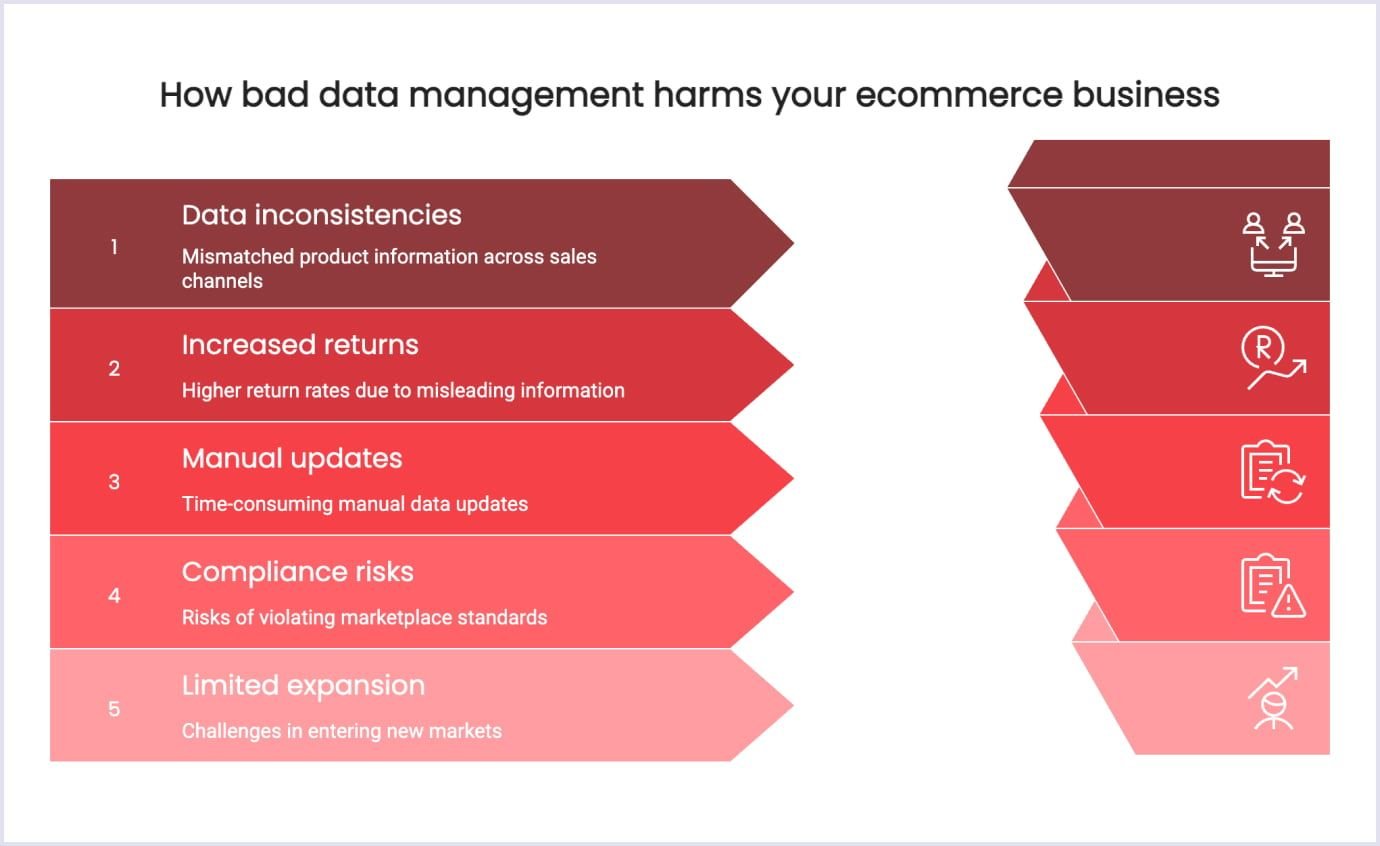
For example, if a customer makes a purchase decision based on incorrect specifications, outdated pricing, or incomplete details, these discrepancies create confusion, increase return rates, and ultimately lead to a loss of customer trust.
A product information management (PIM) system eliminates these risks by ensuring data accuracy across all sales and marketing channels, creating a seamless omnichannel experience for customers.
Aside from customer dissatisfaction, poor product catalog management internally affects business operations on different levels.
Without a centralized product data repository, teams waste time manually updating listings, harmonizing discrepancies, and complying with differing marketplace requirements. This leads to operational roadblocks, higher labor costs, and lost sales opportunities.
With a well-implemented PIM, these processes are streamlined, errors are reduced, updates are automated, and every customer interaction is based on firm, up-to-date product information.

What is a PIM system? Understanding centralized product data management
A product information management (PIM) system is a software solution that houses, organizes, and manages all product data in a single central repository.
It enables organizations to maintain a well-organized and reliable database of product descriptions, technical specifications, images, prices, and other important product information. Centralizing product data enables organizations to improve data accuracy and streamline operations across departments.
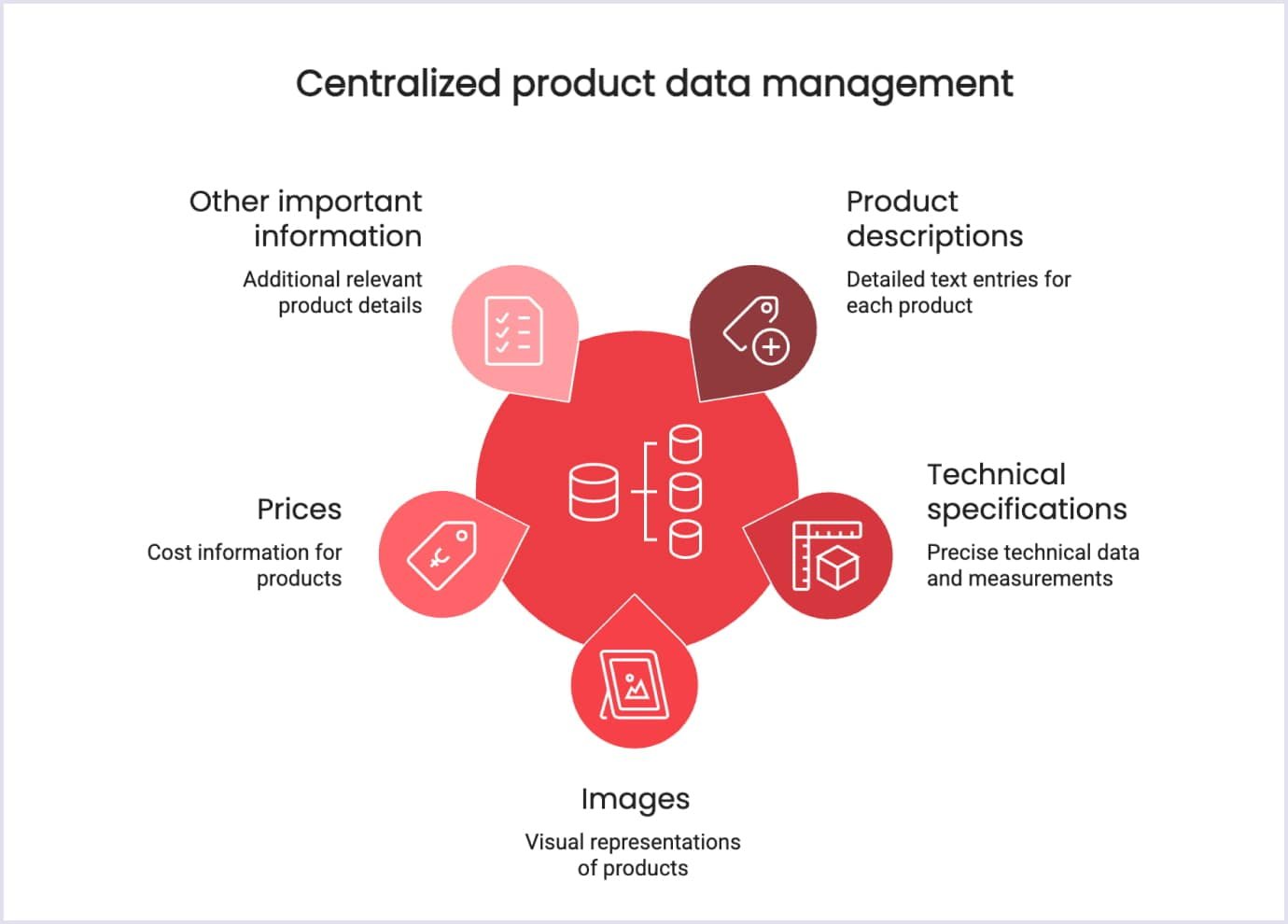
At its core, a PIM system is intended to solve one of the biggest ecommerce and retail pains: having accurate, consistent, and easily accessible product information management on numerous platforms and departments.
Instead of manually updating spreadsheets or working with isolated data sources, businesses use PIM so that they have one, well-groomed source of truth for all product information. This is especially crucial in product catalog management, where there are massive inventories to be organized for optimum efficiency, as well as international market growth, where there must be localization and adaptation for regions seamlessly.
How does a PIM system work?
A PIM system is a hub or hub-and-spoke system that collects product data, cleans it, and distributes it. Following is a step-by-step description of how it works:
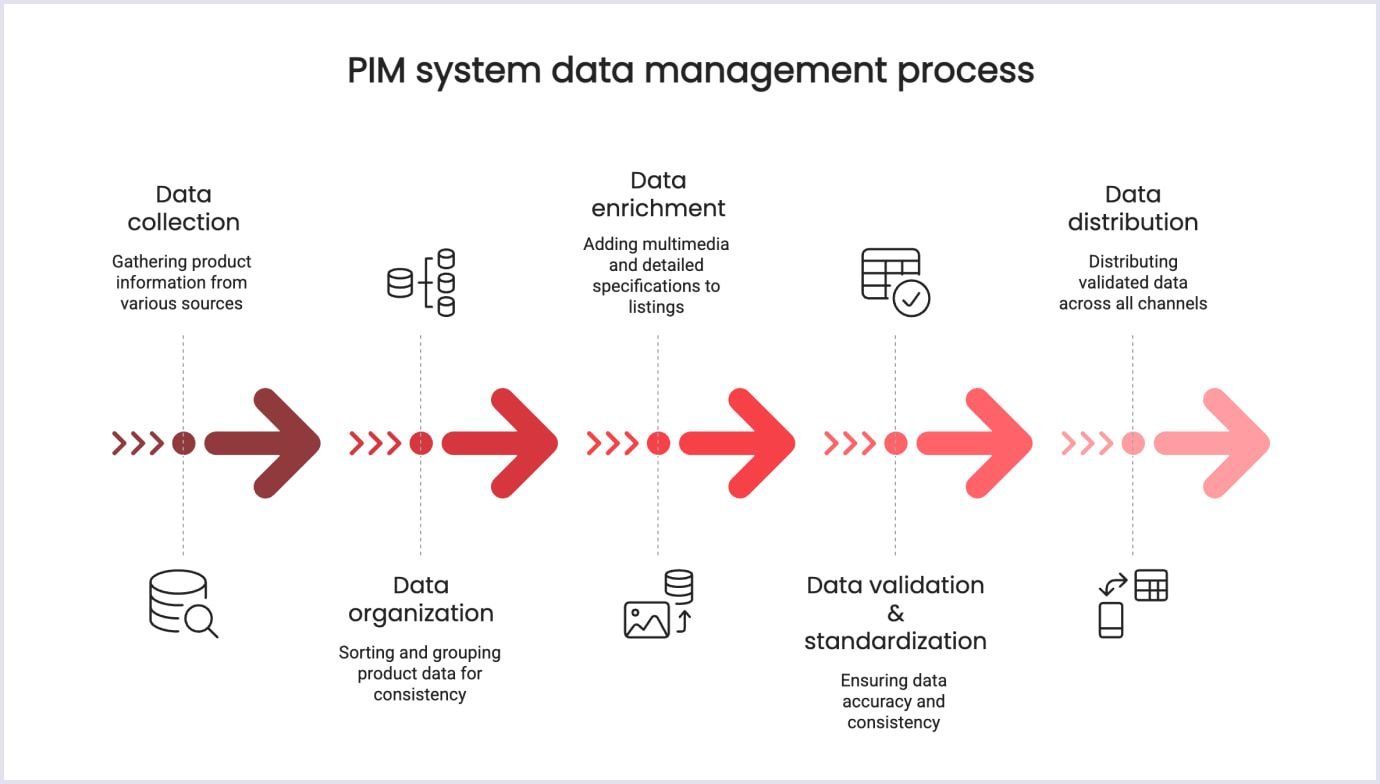
- Data collection. The platform collects product information from multiple internal sources (ERP, PLM, supplier feeds) and external sources (manufacturer catalogs, third-party databases), facilitating supplier collaboration by keeping data consistent between suppliers and retailers.
- Data organization. Product characteristics (name, dimensions, materials, SKUs) are sorted and grouped based on predefined rules to maintain consistency and improve SEO optimization by enriching product listings with relevant metadata.
- Data enrichment. Related content in the form of high-resolution images, videos, marketing copy, and technical specifications is appended to product listings, enhancing digital marketing efforts by making product pages more engaging and informative.
- Data validation & standardization. Incomplete, duplicate, or inconsistent data is validated by the system, ensuring that product information meets industry and company standards, which is critical to improving data accuracy across multiple sales channels.
- Data distribution. Once product data is complete and validated, it is automatically pushed to all sales and marketing channels (marketplaces, ecommerce platforms, mobile apps, print catalogs, etc.) to enable a better omnichannel customer experience.
Why is a PIM system unavoidable?
A PIM system is not just a storage solution but an active controller and optimizer of the product data so that businesses function without any glitches. A PIM system helps companies in:
- Handle massive product catalogs with thousands or even millions of SKUs without losing control.
- Reduce manual effort and errors by automating product updates and ensuring accuracy.
- Easily consolidate data across disparate systems and platforms.
- Enable scalability by making it easier to add new products and expand product lines.
- Streamline PIM system selection by ensuring that companies choose the right platform to meet their specific operational needs.
In simple terms, a PIM system transforms complex product information into an organized, streamlined, and retrievable form so that companies can easily manage catalogs and keep information about their products up to date.

Key benefits of implementing a PIM system for ecommerce growth
A PIM system optimizes product information management from a disjointed process to a systematic, scalable, and automated process. It eliminates the inefficiencies of disconnected data sources, offering centralized product data that is reliable, accurate, and available to every department.
Here are the primary benefits of the utilization of a PIM system for businesses:
- Maintaining a single source of truth, eliminating duplicate and stale data.
- Enabling seamless supplier collaboration, synchronizing vendor data.
- Automation of content distribution, consistent presence across all digital platforms.
- Internal workflow optimization, reducing lost time spent on manual editing.
- Global market outreach amplification, localization of data for multi-regional business.
- Ensuring performance and scalability, allowing businesses to handle growing product lines and growing traffic efficiently.
Companies suffer from inconsistency, manual maintenance, and operational deceleration with no PIM, which hinders scalability and customer experience. With a PIM system, businesses facilitate seamless product catalog management, reducing errors and enhancing productivity.
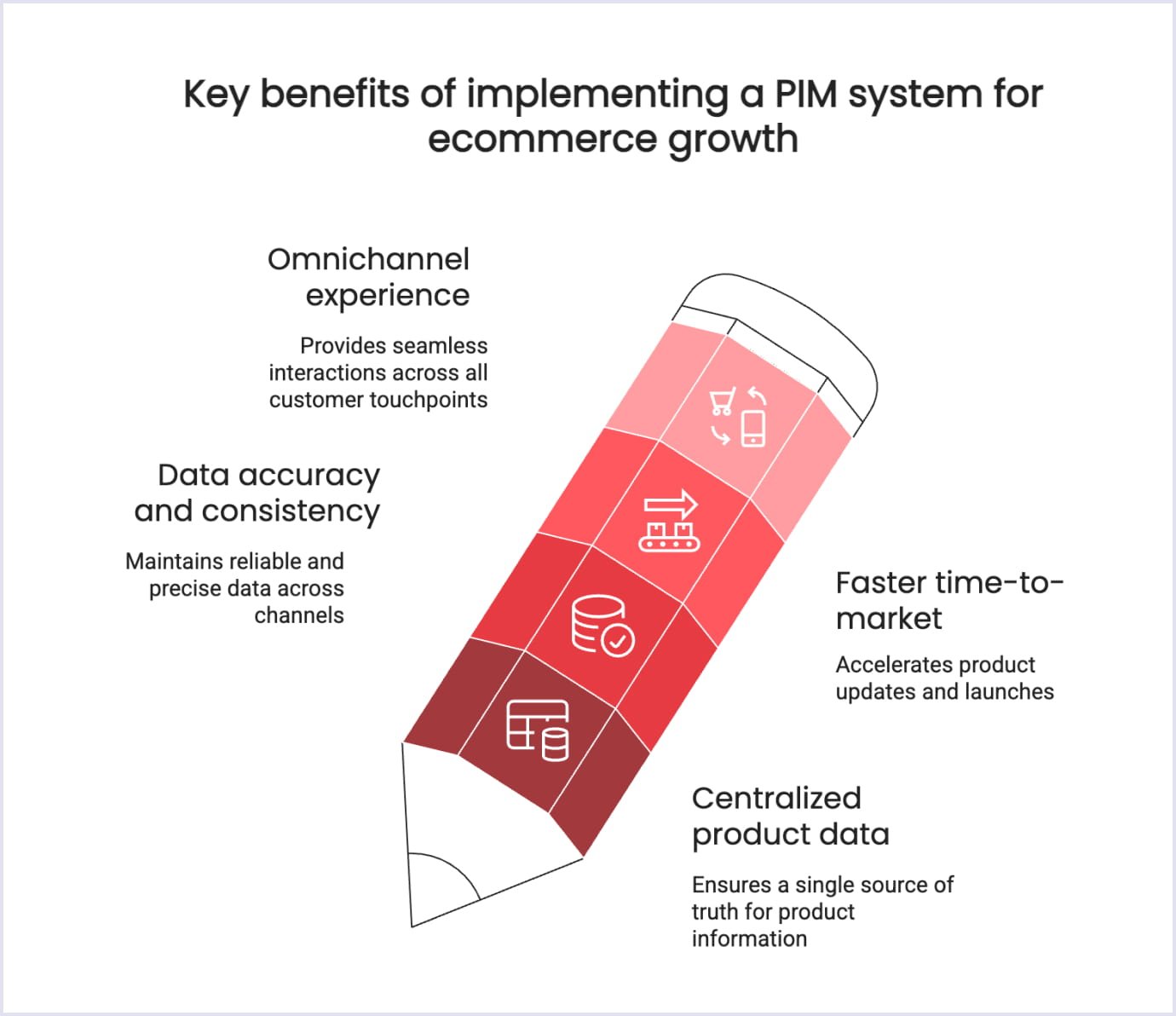
Centralized product data: The foundation of scalable product information management
Disorganized product data jams up product information management, leading to inconsistencies between sales channels and operational inefficiencies. A PIM system aggregates all product-related data and is the basis for a scalable eсommerce platform. Companies are able to efficiently structure, manage, and distribute product content without the drudgery of dealing with multiple sources of data.
With centralized product information, companies gain velocity in product catalog management, with updates being real-time, consistent, and flawless. A PIM solution assists companies in:
- Product data integration across departments, improving coordination and access.
- Keeping the data correct and compliant, reducing discrepancies and compliance issues.
- Mass updates are automated, making prices, descriptions, and stock adjustments easier.
- Enable omnichannel experience, providing customers with consistent information.
- Streamline product launches, eliminating delays in go-to-market initiatives.
For companies wanting to build a marketplace website, a PIM system offers a solid foundation for handling varied product catalogs from multiple suppliers. It also offers easy shipping integrations, so product information, inventory quantity, and shipping options are current on all sales channels.
Enhancing data accuracy and consistency across multiple sales channels
Unreliable product descriptions, incorrect specifications, and out-of-date prices create confusion that erodes customer trust. Data accuracy is critical to maintaining credibility across multiple channels, and a PIM system ensures that all touchpoints reflect consistent and validated product information.
Through a PIM system, companies normalize and enrich product information management on marketplaces, social commerce, and direct-to-consumer platforms. This ensures:
- Correct pricing and attributes, eliminating inconsistencies across channels.
- Automatically validated data, less opportunity for errors and human interventions.
- SEO-optimized product listings, improving search visibility.
- Increased accuracy of stock, obtaining a correct reading of stock counts.
- Enhanced credibility and engagement, establishing brand trust through information accuracy.
With systematic automation, companies can eliminate human errors that impact sales and customer satisfaction.
Faster time-to-market: Streamlining product updates and launches
Without centralized product data, companies struggle with slow updates, scattered information, and delayed global launches. A PIM system streamlines inefficiencies by mechanizing product updates so that information flows seamlessly from creation to delivery.
By integrating product information management with workflow optimization, companies achieve faster time-to-market and are more responsive to customers. A PIM solution supports:
- Automated distribution of data, real-time update of all channels and platforms.
- Effortless supplier collaboration, accelerating product onboarding.
- Batch processing for mass edits, less manual work and faster launches.
- Localized content adaptation, readiness for international markets guaranteed.
- Product catalog dynamic updates, enabling real-time adaptation.
With the growing use of AI in marketplaces, PIM systems are increasingly incorporating AI-driven automation to improve support for product categorization, intelligent recommendations, and predictive analytics, maximizing scalability and personalization.
Elevating the omnichannel experience: Ensuring seamless customer interactions
Today's customers want a seamless omnichannel experience where product information is consistent and personalized across websites, marketplaces, mobile apps, and social media. A PIM system unifies product information across a variety of touchpoints so that customers receive accurate, compelling, and personalized product information at each touchpoint.
By using a PIM system, companies streamline product information management to provide a simple omnichannel experience that builds customer trust. Key benefits include:
- Consistent messaging across channels, eliminating channel inconsistencies.
- Real-time updates of product availability, boosting purchase confidence.
- Improved product descriptions and images, boosting engagement and conversions.
- Seamless digital marketing integration, optimizing campaign performance.
- Optimized cross-channel synchronization, making customer interactions seamless.
A PIM system is not an afterthought. It is the eсommerce success formula that enables frictionless transactions and marketplace growth. As retailers adopt AI innovations, combining AI development services with a PIM system unleashes new levels of productivity, automation, and customer customization, ensuring long-term market success.
Read also: How Much Does It Cost to Build a Marketplace Website in 2025
Common use cases for PIM systems in ecommerce
Behind every smooth ecommerce operation is a system that quietly gets the job done: a PIM platform. But where does it make the biggest difference? Let's take a closer look at the most common (and powerful) ways PIM systems are changing the way digital businesses grow and sell.

Product catalog management: Organizing and structuring large inventories
A massive catalog is only as good as its organization and navigability. Advanced PIM technology uses AI to automatically categorize products, flag inconsistencies, and optimize listings for better discoverability. By eliminating manual entry, companies eliminate errors and provide consistent product data across channels. Real-time updates and dynamic customization keep product data fresh, accurate, and easily scalable.
Global market expansion: Simplifying localization and multi-region selling
Exporting internationally means playing by different rules in each market. PIM platforms enable global market expansion by simplifying complicated compliance requirements, currency conversions, and region-specific pricing in real time. Instead of manually adjusting listings by country, companies can let automation do the work of keeping product specifications in line with local regulatory standards. By adapting product descriptions, images, and promotions based on cultural practices, brands can make a lasting impression and build trust in overseas markets.
Supplier collaboration: Improving efficiency and data consistency with vendors
Ecommerce companies typically have numerous suppliers, resulting in inventory discrepancies, inconsistent product details, and delayed updates. A PIM system is a data repository where suppliers can make real-time updates to inventory quantities, descriptions, and prices. This eliminates delays, reduces manual data entry errors, and improves the accuracy of marketplace listings. By consolidating supplier data, companies can maximize supply chain efficiencies, prevent overselling, and provide a more consistent customer shopping experience.
SEO optimization and digital marketing: Driving more traffic with high-quality product data
A PIM system not only stores information, it optimizes it for search engine optimization and marketing effectiveness. Intelligent keyword inclusion and automatic metadata creation maximize search and ecommerce platform rankings. Well-formatted content, enhanced descriptions, and optimized product pages enable companies to attract more organic traffic while improving conversion rates. Adaptive content approaches also provide dynamic capabilities based on seasonal trends, customer behavior, or emerging marketing opportunities.

PIM system selection: How to choose the right solution for your business
With the use of this systematic six-step selection process, businesses can make an informed decision regarding a PIM system with confidence that not only meets their current requirements but also catalyzes future growth.
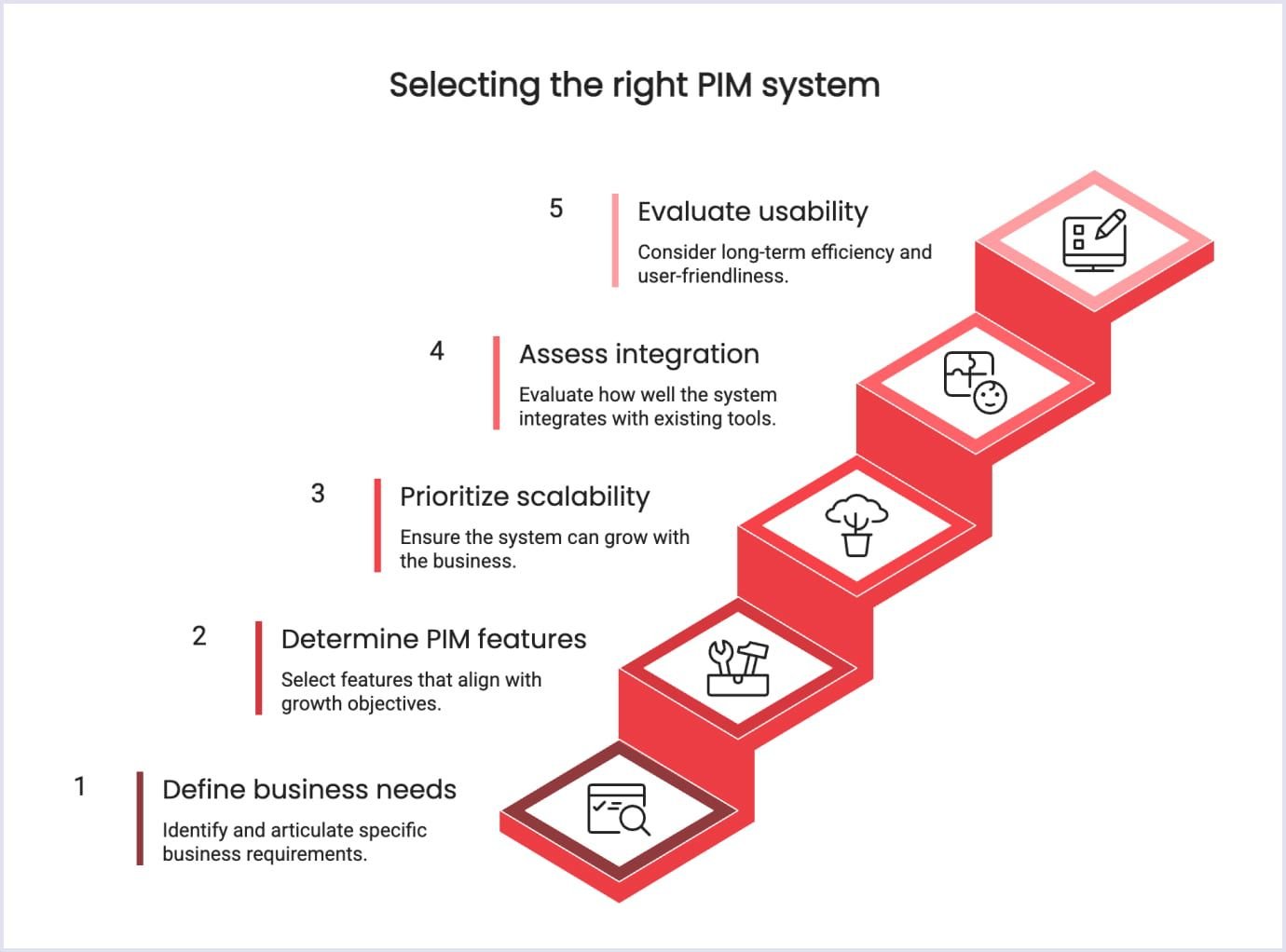
Step 1: Define your business needs during project discovery
Before jumping into a feature comparison, take a step back and determine why you need a PIM system in the first place. This is where the project discovery phase makes all the difference, allowing companies to identify existing pain points, inefficiencies, and opportunities for growth. If you're struggling with multi-channel inconsistencies, slow updates, or barriers to expansion into international markets, identifying these pain points early will save time and avoid unnecessary costs.
If your business is looking to expand into international markets, it's also a good idea to use product discovery services to test localization requirements and local concerns. Every business is different, and the right PIM system should align with your long-term ecommerce growth strategy, not solve the short-term problem.
Step 2: Determine important PIM features that fuel growth
Not all PIMs are equal. Some offer only product warehousing, and others are intelligent centers of automation that drive departmental productivity. The best solutions do more than warehouse product data: they actively optimize, validate, and distribute it to sales channels in real-time.
A strong PIM system should be able to automate product enrichment, deliver error-free catalog updates, and sync seamlessly with marketplaces, ecommerce platforms, and supplier feeds. The ability to handle large-scale catalogs without any performance hit is also critical. Without these high-end features, businesses risk falling behind competitors who can update product data faster and more accurately.
Step 3: Prioritize scalability and future growth potential
A PIM system is an investment in long-term growth, so it must be able to grow with your business without constant upgrades or costly migrations.
Far too many companies make the mistake of selecting a solution based on their current needs, only to find that it cannot scale with their expanding product lists or multi-market mandates.
Scalability isn't just about the number of SKUs a system supports. It's also about how effectively it supports automated updates, new sales channels, and changing market trends. If you plan to grow internationally, the system should support multiple currencies, languages, and regulatory bodies without adding complexity to your operations.
Step 4: Assess integration capabilities and avoid data silos
A PIM that does not harmonize with your current tech stack is a burden, not a benefit. Your product information needs to move between your ecommerce platform, ERP, CRM, and marketing automation seamlessly, providing one source of truth for all your channels.
Inadequate integration leads to data silos, sync issues, and inefficiencies in the business, requiring teams to spend hours updating product information across many platforms manually. With a PIM possessing great integration capabilities, all of these obstacles disappear, allowing firms to focus on growth and not data upkeep.
Step 5: Look for usability, support, and pricing for long-term efficiency
Even the best PIM system is wasted if your staff is not able to work with its interface or requires extensive training to work efficiently with it. Usability is the most overlooked, yet it significantly contributes to employee adoption and business performance. The system should have an easily usable design that allows teams to manage product data, track changes, and generate insights without frustration.
Customer support is equally important. A PIM provider that offers 24/7 support, onboarding assistance, and dedicated account managers can make the difference between a seamless transition and months of troubleshooting headaches.
Finally, price needs to be considered in terms of more than just up-front cost. Subscription models may be low-cost up-front but potentially expensive down the road as SKU volume grows. Upfront license fees may be higher initially but ultimately less. Firms need to choose a model based on their anticipated growth, not just their current budget.
Step 6: Test before you commit
Never make a PIM decision without testing it out in a production environment. A demo or trial allows you to test how well the system integrates, how fast it processes bulk updates, and how well automation functions work. The best way to test a PIM system is to simulate high-volume product updating via different channels and check the response time. If the system is not performing well or requires excessive manual tuning, it's not the best option.
Furthermore, quality assurance services testing should be implemented by companies to guarantee that product information is verified, normalized, and error-free before live deployment.
Elevate your ecommerce operations with smarter product information management
In ecommerce, every detail matters: from accurate product descriptions to effortless multichannel management. A PIM system ensures that your business runs with accuracy, providing consistent, high-quality product data that drives conversions and customer confidence.
The brands that thrive are the ones that invest in structured, scalable product management. Is yours one of them?
At Codica, we specialize in creating custom ecommerce solutions that drive efficiency and new avenues of expansion. Browse our portfolio to learn more about how we help companies achieve their eсommerce goals with innovative solutions.
Your product data is your storefront: make it flawless with PIM. Contact us to take your business to the next level.
